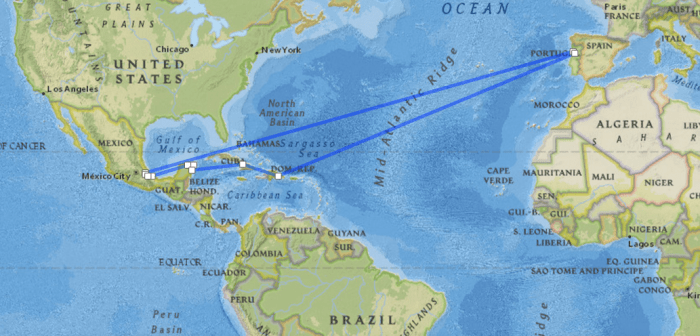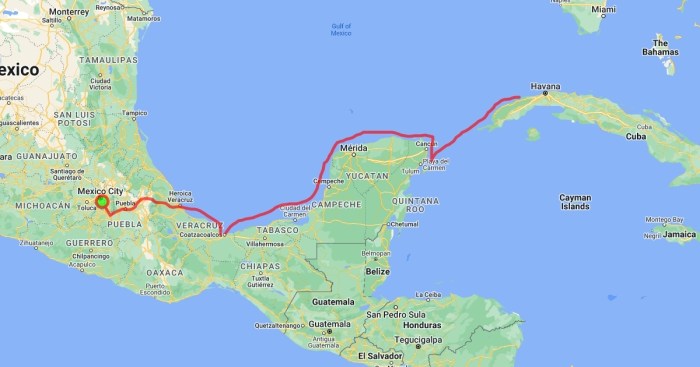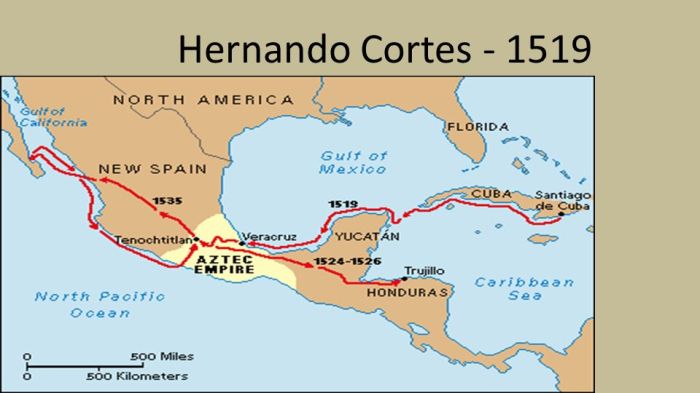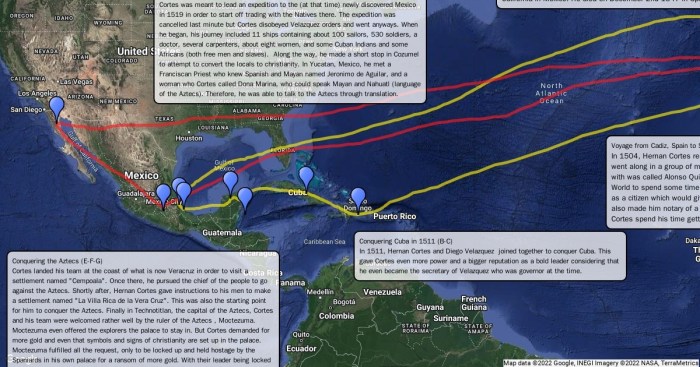Map of hernan cortes route – Embark on a captivating journey through the map of Hernan Cortes’ route, where we trace the footsteps of the renowned conquistador as he navigated the treacherous landscapes of Mesoamerica. Join us as we uncover the challenges, triumphs, and lasting impact of this pivotal expedition.
This comprehensive guide delves into the historical context, key landmarks, and controversies surrounding Cortes’ route, providing a multifaceted perspective on its significance.
Hernan Cortes’ Route

Hernan Cortes’ route, spanning from Cuba to the Aztec capital of Tenochtitlan, holds immense historical significance. It marked the beginning of the Spanish conquest of Mexico, leading to the downfall of the Aztec Empire and the establishment of Spanish rule over Mesoamerica.
Cortes’ expedition set sail from Cuba in February 1519, landing on the coast of what is now Mexico. From there, they embarked on a perilous journey inland, navigating treacherous terrain and facing fierce resistance from indigenous tribes.
Hernan Cortes’s daring journey across Mexico is chronicled in maps that reveal his intrepid path. If you’re curious about the specifics of his route, I highly recommend checking out the apes unit 1 test answers . These comprehensive resources provide detailed information on Cortes’s travels and the impact they had on the region.
Once you’ve delved into the fascinating world of apes unit 1 test answers, you’ll have a deeper understanding of Cortes’s expedition and its historical significance.
Challenges and Obstacles
Cortes and his expedition faced numerous challenges throughout their journey. These included:
- Hostile terrain:The expedition traversed dense jungles, arid deserts, and rugged mountains.
- Indigenous resistance:Native tribes, particularly the Tlaxcalans, initially opposed Cortes’ advance, leading to bloody battles.
- Disease:European diseases, such as smallpox and measles, decimated the indigenous population, weakening their resistance.
- Lack of supplies:The expedition often struggled to find food and water, particularly in hostile territory.
Despite these obstacles, Cortes’ determination and strategic alliances with indigenous groups, such as the Tlaxcalans, ultimately led to his success in reaching Tenochtitlan and conquering the Aztec Empire.
Map of Hernan Cortes’ Route

A comprehensive map of Hernan Cortes’ route provides a visual representation of his remarkable expedition. It includes key landmarks, cities, and geographical features that he encountered along the way. Different colors or markers can be used to highlight the various stages of his journey, making it easier to understand the scope and complexity of his undertaking.
Landmarks and Cities
The map should include significant landmarks and cities that Cortes passed through during his expedition. These include:
- Cozumel Island: The island where Cortes first landed in Mexico.
- Veracruz: The city founded by Cortes as a base for his operations.
- Tenochtitlan: The Aztec capital city that Cortes conquered.
- Cholula: A large city that Cortes passed through on his way to Tenochtitlan.
- Montezuma’s Palace: The palace where Cortes met with the Aztec emperor, Montezuma II.
Geographical Features
The map should also include important geographical features that Cortes encountered during his expedition. These include:
- Gulf of Mexico: The body of water that Cortes sailed through to reach Mexico.
- Sierra Madre Oriental: The mountain range that Cortes crossed on his way to Tenochtitlan.
- Valley of Mexico: The valley where Tenochtitlan was located.
- Lake Texcoco: The lake that surrounded Tenochtitlan.
Historical Context of the Expedition: Map Of Hernan Cortes Route

Hernan Cortes’ expedition to Mesoamerica in the early 16th century was a pivotal event in the history of the Americas. Driven by a thirst for adventure, wealth, and religious zeal, Cortes and his crew embarked on a perilous journey that would forever alter the course of history.
Motivations and Goals
Cortes and his crew were motivated by a complex blend of factors. The allure of gold and other riches was a primary driver, as the Spanish had heard tales of vast treasures in the New World. Additionally, the desire to spread Christianity and claim new lands for the Spanish crown played a significant role in their motivations.
Impact on Indigenous Populations, Map of hernan cortes route
The arrival of Cortes and his expedition had a profound impact on the indigenous populations of Mesoamerica. The Spanish brought with them diseases, weapons, and a ruthless determination to conquer. The indigenous peoples were decimated by disease and warfare, and their societies were irrevocably altered by the Spanish conquest.
Legacy of Hernan Cortes’ Route

The expedition of Hernan Cortes had a profound and lasting impact on the exploration and colonization of the Americas. Cortes’ route became a vital artery for trade and travel between Spain and its New World colonies.
Impact on Exploration and Colonization
Cortes’ route opened up vast new territories for Spanish exploration and conquest. The expedition’s success inspired other Spanish conquistadors to embark on their own expeditions, leading to the establishment of a vast Spanish empire in the Americas.
- The route facilitated the establishment of trade routes between Spain and its colonies, leading to the exchange of goods and ideas.
- Cortes’ expedition paved the way for the colonization of Mexico and other parts of Central and South America.
Historical Significance and Controversies
Cortes’ legacy is both celebrated and contested. While his expedition brought about significant historical changes, it also resulted in the conquest and subjugation of indigenous peoples.
- Cortes’ conquest of the Aztec Empire marked a turning point in the history of the Americas, leading to the decline of indigenous civilizations and the rise of European colonialism.
- The expedition’s brutality and violence against indigenous populations have been the subject of much historical debate and controversy.
Question & Answer Hub
What was the significance of Hernan Cortes’ route?
Cortes’ route played a pivotal role in the conquest of the Aztec Empire, leading to the establishment of Spanish rule in Mexico and transforming the political landscape of Mesoamerica.
What were the key challenges faced by Cortes and his expedition?
Cortes’ expedition encountered numerous challenges, including hostile indigenous populations, treacherous terrain, and limited supplies. Despite these obstacles, Cortes’ determination and strategic prowess enabled him to overcome adversity.
How did Cortes’ expedition impact the indigenous populations of Mesoamerica?
Cortes’ conquest had a devastating impact on the indigenous populations of Mesoamerica, leading to widespread disease, displacement, and cultural disruption. The expedition also marked the beginning of Spanish colonialism in the region.